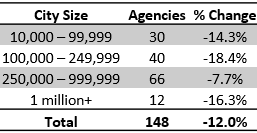The YTD Murder Dashboard has undergone a bit of expansion in the last few months, growing from around 100 cities to nearly 150 as of the end of August. Many of these additions are from smaller towns with the goal of identifying every possible city with available data. This well help balance the sample a little and ensure it’s not just giant cities that are overstating a national trend.
The sample’s composition has changed slightly, but the decline has been remarkably consistent since we launched for 2023:
March -11%
April -10.2%
May -11.7%
June -10.5%
July -12%
August -12.2%
Breaking down the sample by population size shows pretty remarkable consistency. Of note, we now have data from all 12 cities that had 1 million or more people in 2020 and over 80 percent of agencies between 250,000 and 1 million people (more on why this matters in a later post).
I should also note that some of the data is being skewed by two outliers which are likely overstating the trends for their population groups in opposite directions: San Antonio and Memphis. No city has had a larger murder increase than Memphis this year. Meanwhile, San Antonio’s murder decrease is largely tied to the deaths of 53 migrants last year that are being counted as murders. Murder is still down in San Antonio if you remove those deaths, but not nearly as much. If you take out these two outlier cities then murder is down over 10 percent in cities 250,000 to 1 million and down 14 percent in cities with more than 1 million people.
Another piece of the puzzle is the Gun Violence Archive data which is slowly but steadily moving towards the city data. Here is the approximate YTD percent change in fatal shooting victims at the end of each month this year in GVA:
January +4.3%
February -2.1%
March -2.7%
April -3.7%
May -3.7%
June -5.1%
July -6.0%
August -6.2%
The last piece of the puzzle if the FBI’s quarterly crime data which was quietly released on August 28th covering the first half of the year. The bad news is that the FBI wasn’t able to make national estimates due to insufficient participation. The seeming good news is that there is midyear data on 223 agencies with over 100,000 people showing an 18 percent decline in murder through midyear.
Unfortunately, this data is not audited and a comparison of midyear crime data reported by the FBI with accurate midyear crime data reported by the Major Cities Chiefs Association shows numerous problems with the FBI data. A quick perusal of the two datasets shows pretty glaring differences between FBI and MCCA in the below 10 cities with the latter largely matching what cities are publicly reporting much closer.
So while the quarterly crime data should probably be ignored, the city data has remained consistent, and the GVA data is showing a steadily increasing decline. These signs continue to point to a large decrease in murder nationally occurring in 2023 following the historic increases of 2020 and 2021.







Hi Jeff: So the only item we have from the FBI that's worth looking at is state-locality totals for the first six months of 2023?
Suggestion: You need to do a "Dummies" guide to using the Crime Data Explorer. I've been looking at (and explaining) FBI crime data for decades and I have to spend a ton of time just to remind myself as to how to use this tool. It's obvious that the FBI has no intention of making this process easier.
We appreciate your time and explanations. Best, Len.